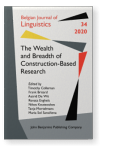Making good on a promise
Multidimensional constructions
Construction Grammar was founded on the promise of maximal empirical coverage without compromising on formal
precision. Its main claim is that all linguistic knowledge can be represented as constructions, similar to the notion of
constructions from traditional grammars. As such, Construction Grammar may finally reconcile the needs of descriptive and
theoretical linguistics by establishing a common ground between them. Unfortunately, while the construction grammar community has
developed a sophisticated understanding of what a construction is supposed to be, many critics still believe that a construction
is simply a new jacket for traditional linguistic analyses and therefore inherits all of the problems of those analyses. The goal
of this article is to refute such criticisms by showing how constructions can be formalized as open-ended and multidimensional
linguistic representations that make no prior assumptions about the structure of a language. While this article’s proposal can be
simply written down in a pen-and-paper style, it verifies the validity of its approach through a computational implementation of
German field topology in Fluid Construction Grammar.
Article outline
- 1.The promise of construction grammar
- 2.A new jacket for mainstream analyses?
- 3.Open-Ended and multidimensional constructions
- 4.How does it work? An example from German field topology
- 5.Conclusion
-
References
References (34)
References
Barðdal, Jóhanna. 2009. “The Development of Case in Germanic.” In The Role of Semantic, Pragmatic, and Discourse Factors in the Development of Case, ed. by Jóhanna Barðdal, and Shobhana L. Chelliah, 123–159. Amsterdam/Philadelphia: John Benjamins. 

Blake, Barry J. 1983. “Structure and Word Order in Kalkatungu: The Anatomy of a Flat Language.” Australian Journal of Linguistics 3(2): 143–175. 

Bod, Rens. 2009. “Constructions at Work or at Rest?” Cognitive Linguistics 20(1): 129–134. 

Chomsky, Noam. 1957. Syntactic Structures. The Hague/Paris: Mouton. 

Chomsky, Noam. 1981. Lectures on Government and Binding. The Pisa Lectures. Dordrecht: Foris Publications.
Croft, William. 2001. Radical Construction Grammar: Syntactic Theory in Typological Perspective. Oxford: Oxford University Press. 

Croft, William. 2003. “Lexical Rules vs Constructions: A False Dichotomy.” In Motivation in Language Studies: Studies in Honour of Günter Radden, ed. by Hubert Cuyckens, Thomas Berg, René Dirven, and Klaus-Uwe Panther, 49–68. Amsterdam/Philadelphia: John Benjamins. 

Croft, William. 2010. “Ten Unwarranted Assumptions in Syntactic Argumentation.” In Language Usage and Language Structure, ed. by Kasper Boye, and Elisabeth Engberg-Pedersen, 313–350. Berlin: Mouton De Gruyter.
Dik, Simon. 1997. The Theory of Functional Grammar. Part 1: The Structure of the Clause. Berlin: Mouton De Gruyter.
Drach, Erich. 1937. Grundgedanken der deutschen Satzlehre. Frankfurt am Main: Diesterweg.
Evans, Nicholas, and Stephen C. Levinson. 2009. “The Myth of Language Universals: Language Diversity and Its Importance for Cognitive Science.” Behavioral and Brain Sciences 321: 429–492. 

Fillmore, Charles J., Kay, Paul, and Mary Catherine O’Connor. 1988. “Regularity and Idiomaticity in Grammatical Constructions: The Case of Let Alone .” Language 64(3): 501–538. 

Fried, Mirjam, and Jan-Ola Östman. 2004. “Construction Grammar: A Thumbnail Sketch.” In Construction Grammar in a Cross-Language Perspective, ed. by Mirjam Fried, and Jan-Ola Östman, 11–86. Amsterdam/Philadelphia: John Benjamins. 

Gil, David. 2013. “Riau Indonesian: A Language Without Nouns and Verbs.” In Flexible Word Classes. Typological Studies of Underspecified Parts of Speech, ed. by Jan Rijkhoff, and Eva van Lier, 89–130. Oxford: Oxford University Press. 

Goldberg, Adele E. 2013. “Argument Structure Constructions Versus Lexical Rules or Derivational Verb Templates.” Mind & Language 28(4): 435–465. 

Hale, Kenneth. 1983. “Warlpiri and the Grammar of Non-Configurational Languages.” Natural Language and Linguistic Theory 1(1): 5–74. 

Haspelmath, Martin. 2009. “Framework-Free Grammatical Theory.” The Oxford Handbook of Grammatical Analysis, ed. by Bernd Heine, and Heiko Narrog, 341–365. Oxford: Oxford University Press. 

Lichte, Timm, and Laura Kallmeyer. 2017. “Tree-Adjoining Grammar: A Tree-Based Constructionist Grammar Framework for Natural Language
Understanding.” In: The AAAI 2017 Spring Symposium on Computational Construction Grammar and Natural Language Understanding: Technical Report
SS-17-02, 205–212. Stanford: AAAI Press.
Micelli, Vanessa. 2012. “Field Topology and Information Structure: A Case Study for German Constituent Order.” Computational Issues in Fluid Construction Grammar, ed. by Luc Steels, 178–211. Berlin: Springer. 

Michaelis, Laura A. 2009. “Sign-Based Construction Grammar.” The Oxford Handbook of Linguistic Analysis, ed. by Bernd Heine, and Heiko Narrog, 155–176. Oxford: Oxford University Press.
Müller, Stefan, and Stephen Wechsler. 2014. “Lexical Approaches to Argument Structure.” Theoretical Linguistics 40(1–2):1–76. 

Nordlinger, Rachel. 1998. A Grammar of Wambaya, Northern Territory (Australia). Canberra: Pacific Linguistics.
Nordlinger, Rachel. 2014. “Constituency and Grammatical Relations in Australian Languages.” In The Languages of Australia: A Comprehensive Guide, ed. by Harold Koch, and Rachel Nordlinger, 215–261. Berlin: Mouton De Gruyter. 

Osborne, Timothy, and Thomas Gross. 2012. “Constructions are Catenae: Construction Grammar Meets Dependency Grammar.” Cognitive Linguistics 231: 165–216. 

Pollard, Carl, and Ivan A. Sag. 1994. Head-Driven Phrase Structure Grammar. Chicago/Stanford: University of Chicago Press/CSLI Publications.
Sag, Ivan A., Kaplan, Ronals, Karttunen, Lauri, Kay, Martin, Pollard, Carl, Shieber, Stuart, and Annie Zaenen. 1986. “Unification and Grammatical Theory.” Proceedings of the West Coast Conference on Formal Linguistics, 51: 238–254.
Steels, Luc. 2004. “Constructivist Development of Grounded Construction Grammars.” In Proceedings of the 42nd Annual Meeting of the Association for Computational Linguistics (ACL-04), 9–16. Barcelona: ACL. 

Tesnière, Lucien. 1959. Eléments de Syntaxe Structurale. Paris: Klincksieck.
Van de Velde, Freek. 2009. De Nominale Constituent: Structuur en Geschiedenis [The noun phrase: Structure and diachrony]. Leuven: Leuven University Press.
van Trijp, Remi. 2014. “Long-Distance Dependencies Without Filler-Gaps: A Cognitive-Functional Alternative in Fluid Construction
Grammar.” Language and Cognition 6(2): 242–270. 

Wells, Rulon S. 1947. “Immediate Constituents.” Language 23(2):81–117. 

Cited by (3)
Cited by three other publications
Ungerer, Tobias & Stefan Hartmann
2023.
Constructionist Approaches,

Ungerer, Tobias
2022.
Extending structural priming to test constructional relations: Some comments and suggestions.
Yearbook of the German Cognitive Linguistics Association 10:1
► pp. 159 ff.

This list is based on CrossRef data as of 4 july 2024. Please note that it may not be complete. Sources presented here have been supplied by the respective publishers.
Any errors therein should be reported to them.
